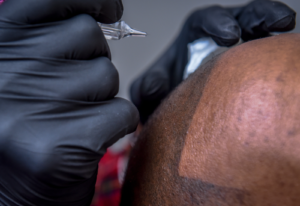If you have experienced significant hair loss, your self-esteem may have taken a hit. Most people prefer the look of full, healthy hair. However, hair loss is more common than you may realize, affecting about 2/3 of men by age 35 and 1/3 of women at some point in life. This very normal problem has an array of solutions, even for those who are uninterested in or unable to undergo surgical hair restoration. Read on for Eldorado’s guide to nonsurgical hair replacement methods.
1. Hair Systems
Hair systems are one of the most popular choices when it comes to nonsurgical hair replacement. They are high quality wigs and hair pieces. They are made from human hair and designed to look like the client’s natural hair. Hair systems are usually made with a polyurethane base that sits on the scalp. A hair system stylist can work with you to achieve the ideal and most-natural-looking result.
A hair system is a good choice for anyone who wants a quick hair replacement solution rather than a surgical procedure that can require some recovery time. They are also usually a more affordable hair restoration choice than other methods. It is important to work with an experienced hair replacement professional who can provide you with quality hair systems rather than cheap, artificial ones that will look fake and probably won’t last long.
2. Topical Hair Loss Solutions
In many cases, there are topical hair loss products that can help with hair regrowth. Foams and/or liquid products are applied to the scalp directly and regularly. They contain things like tretinoin, minoxidil, and more. Use topical products under the direction and guidance of a qualified medical professional.
3. Platelet-Rich Plasma Therapy (PRP)
PRP therapy services can help people who have experienced hair thinning and hair loss. It involves using an individuals platelets taken from a blood sample and injecting them into their scalp. Compared with other hair replacement methods, it is relatively new, and is being used to treat a range of medical conditions. It is, however, considered to be one of the most effective methods for hair regrowth. PRP therapy is not a suitable option for all clients. It is best for those with thinning hair or hair loss where follicles are still functional, as well as those who are not experiencing any serious health conditions or diseases.
4. Low-Level Light Therapy (LLLT)
LLLT is a nonsurgical treatment for hair loss. It makes use of low-intensity light to stimulate epidermal stem cells within the hair follicle. It encourages these stem cells to grow. This treatment has been in use by hair replacement professionals since the 1960s. It is a common treatment for those who have experienced hair loss related to illness, menopause, and the postpartum period. It is generally not used in areas of total baldness.
5. Human Hair Extensions
Hair extensions are an increasingly popular choice for those who are unhappy with their natural hair. While they may not be the best choice for progressed hair loss, they are a great way to add fullness to thin or thinning hair. Human hair extensions can be colored and styled by an experienced hair extension professional to look and feel like your natural hair.
There are may different types of hair extensions available. For those looking for a fast, affordable hair extensions solution, clip-ins are a great choice. If you are looking for permanent hair extensions, there are a variety of attachment methods available, such as:
- Keratin bond
- Micro link/microbead
- I-tip
- Tape-in
- Fusion bond
- Sew-in
None of these are considered surgical hair extension methods. However, some are more invasive than others. Depending on your hair goals, there is most definitely an ideal option for you. Consult with a hair replacement expert to determine your best option.
6. Scalp Micropigmentation (SMP)
SMP is an alternative hair replacement solution that does not involve actually replacing the hair. In this method, small dots are tattooed on the scalp to give the appearance of thicker hair. It is often used to treat scarring alopecia and male pattern baldness. It’s a great option for covering up hair transplant scarring, and the process is relatively painless. It also does not require a recovery time, and usually very little maintenance and/or few touchups are needed.
Contact a Baltimore Hair Replacement Service
If you are tired of dealing with thinning hair or hair loss, do something about it! Contact Eldorado to learn about our high-quality hair replacement services performed by experienced, licensed technicians. No matter how progressed your hair loss may be, we can help. We believe we have a solution to virtually any hair loss problem. Call (410) 931-3399, or schedule your free hair analysis at our Baltimore hair replacement center today.




